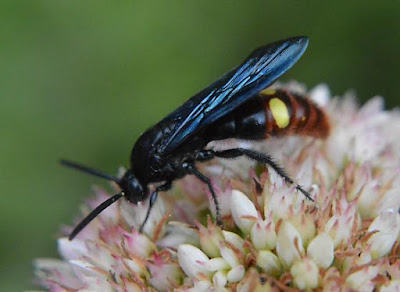Weed of the month for July 2015 is Common Purslane
Purslane
 |
| Fig. 1. Common purslane. |
 |
| Fig. 2. Common purslane in thin turf. |
 |
| Fig. 3. Arrows marking purslane seedlings. |
 |
| Fig. 4. Common purslane is a common weed along sidewalks and in gardens and landscape beds. |
 |
| Fig. 5. Ornamental purslane. "Toucan Hot Mix' shown. |
Identification: A succulent broadleaf, purslane has fleshy, glabrous (smooth) leaves and stems. Leaves are green with a red margin, lack a petiole, and are rounded at the tip. Additionally, the leaves of purslane can be alternately arranged near the crown of the plant and become opposite or whorl-like towards the apex. Stems are plump, red in color, and originate from a central point to from a rosette. Prostrate spurge is a look-a-like weed to purslane (Fig. 6). Prostrate spurge will have smaller leaves and stems and a more strictly opposite leaf arrangement that purslane. Additionally, spurge, like milkweed, will exude a white sap when the stem is severed. Purslane has a yellow flower (Figs. 7 & 8) that is rarely seen and following pollination, its seed pods (Fig. 9) can hold many seeds (Fig. 10).
 |
| Fig. 6. Prostrate spurge (left) and common purslane (right). |
 |
| Fig. 7. Common purslane flowering. |
 |
| Fig. 8. Close-up of the common purslane flower. |
 |
| Fig. 9. Following pollination and ovule fertilization, a seed pod encapsulates the seed. |
 |
| Fig. 10. When the seed pod opens, many seeds (>20) per pod are spilled onto the ground. |
Cultural control: Common purslane is generally not an issue in a healthy and well-established turf stand, but it can be found in thin or newly established areas. Thus, cultural practices that improve the competitive ability of the existing turf and/or promote the establishment of a new stand are the best methods of purslane management, prevention, and control.
Biological control: The purslane sawfly (Schizocerella pilicornis) and the portulca leaf-mining weevil (Ceutorhynchus portulacea or Hypurus portulacea) can contribute to reducing purslane infestations, though total control may not be realistic.
Chemical control:Triclopyr, fluroxypyr, and dicamba are the most effective herbicides for postemergent purslane control in cool-season turf. In addition to the herbicides already listed, metsulfuron or a combination of sulfentrazone and metsulfuron can be used in warm-season turf for postemergent purslane control. For preemergent purslane control, spring applications of isoxaben or late-winter applications of simazine can be used in cool-season and warm-season turf, respectively.
For more information on weed control, search this blog and check out our Turfgrass Weed Control for Professionals Publication.
For archives of past weed of the month postings, visit our Weed of the Month Archive.
Quincy Law, Graduate Research Assistant, Purdue University
Aaron Patton, Turfgrass Extension Specialist, Purdue University
Follow @PurdueTurfDoc
References:
- Darlington, H.T. and G.P. Steinbauer. 1961. The eighty-year period for Dr. Beal’s Seed Viability Experiment. American Journal of Botany 48:321-325.
- Miyanishi, K. and P.B. Cavers. 1981. Effects of hoeing and rototilling on some aspects of the population dynamics of pure stands of Portulaca oleracea L. (purslane). Weed Research 21:47-58.
- Proctor, Christopher. 2013. Biology and control of common purslane (Portulaca oleracea L.). Ph.D. Thesis, University of Nebraska-Lincoln.
- Zimmerman, C.A. 1970. The causes and characteristics of weediness in Portulaca oleracea L. Ph.D. Thesis, University of Michigan.



























